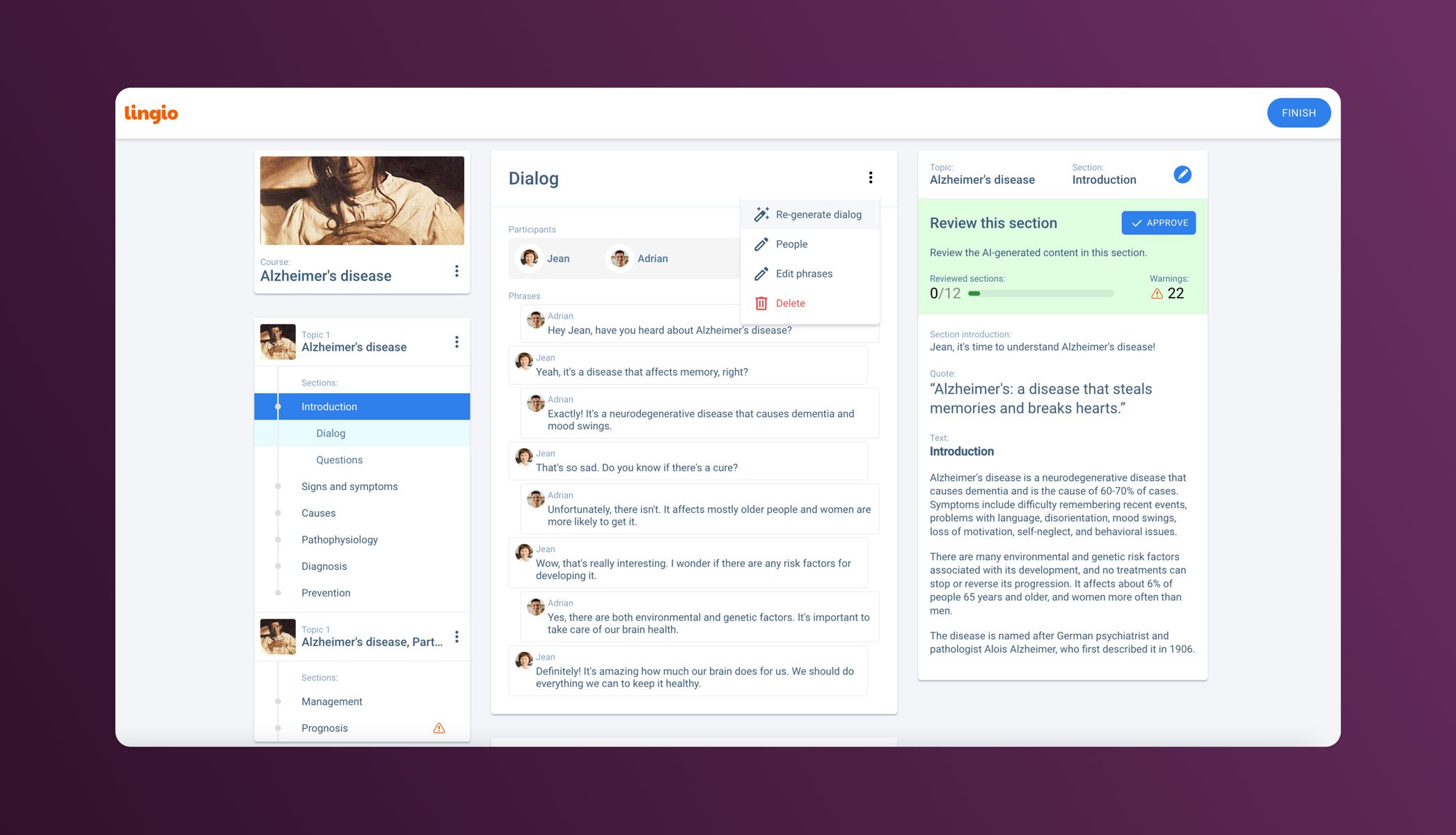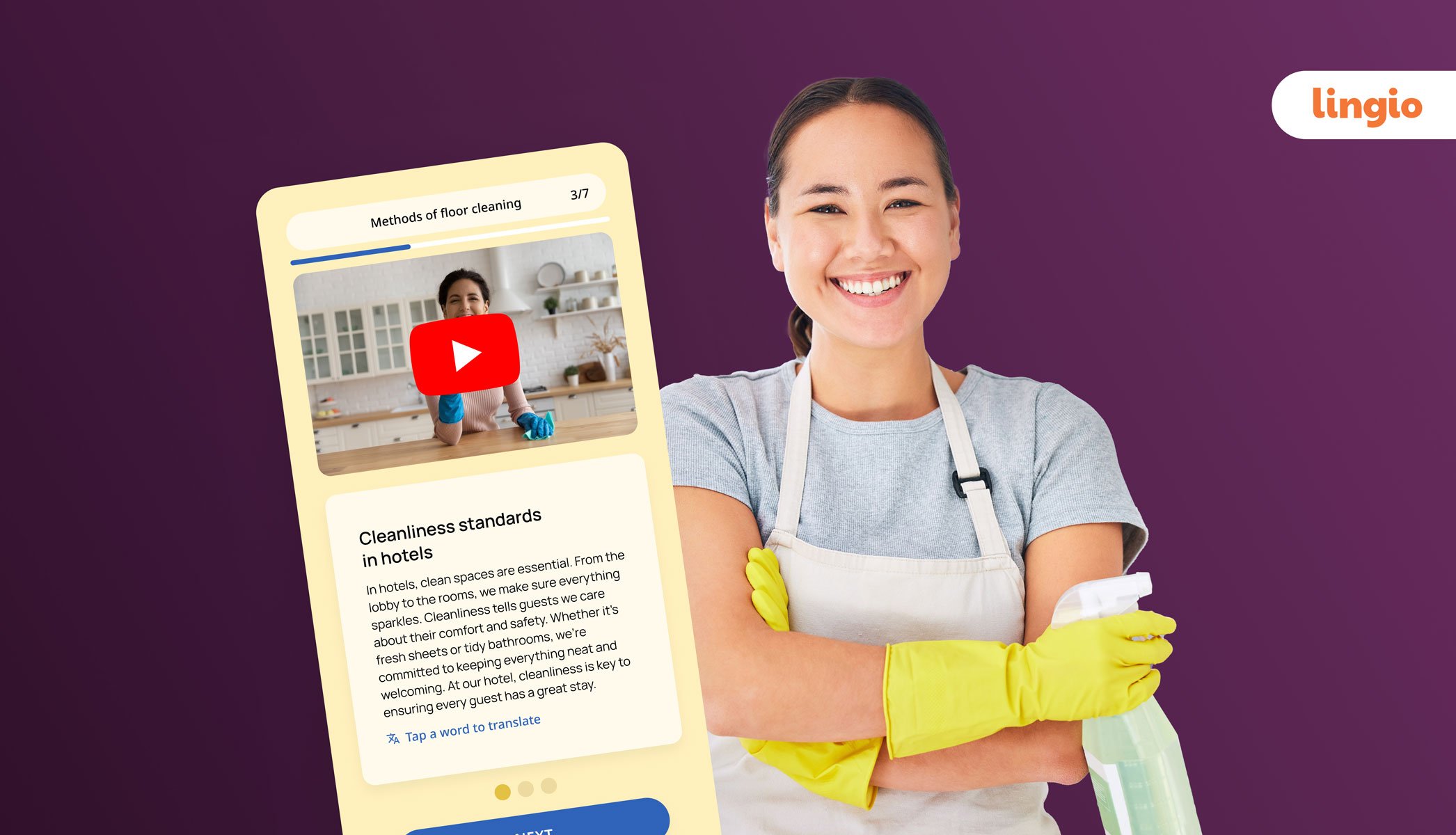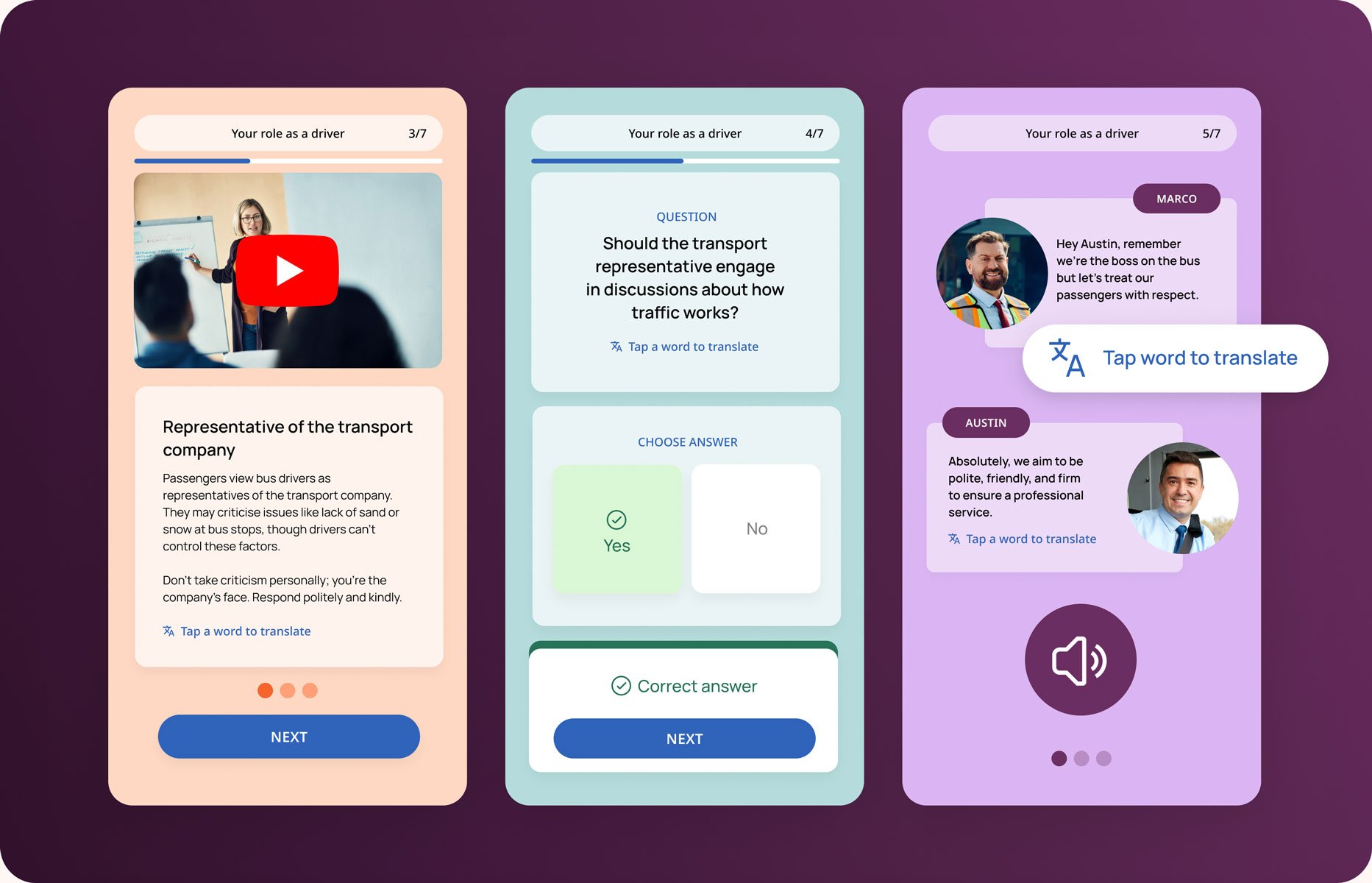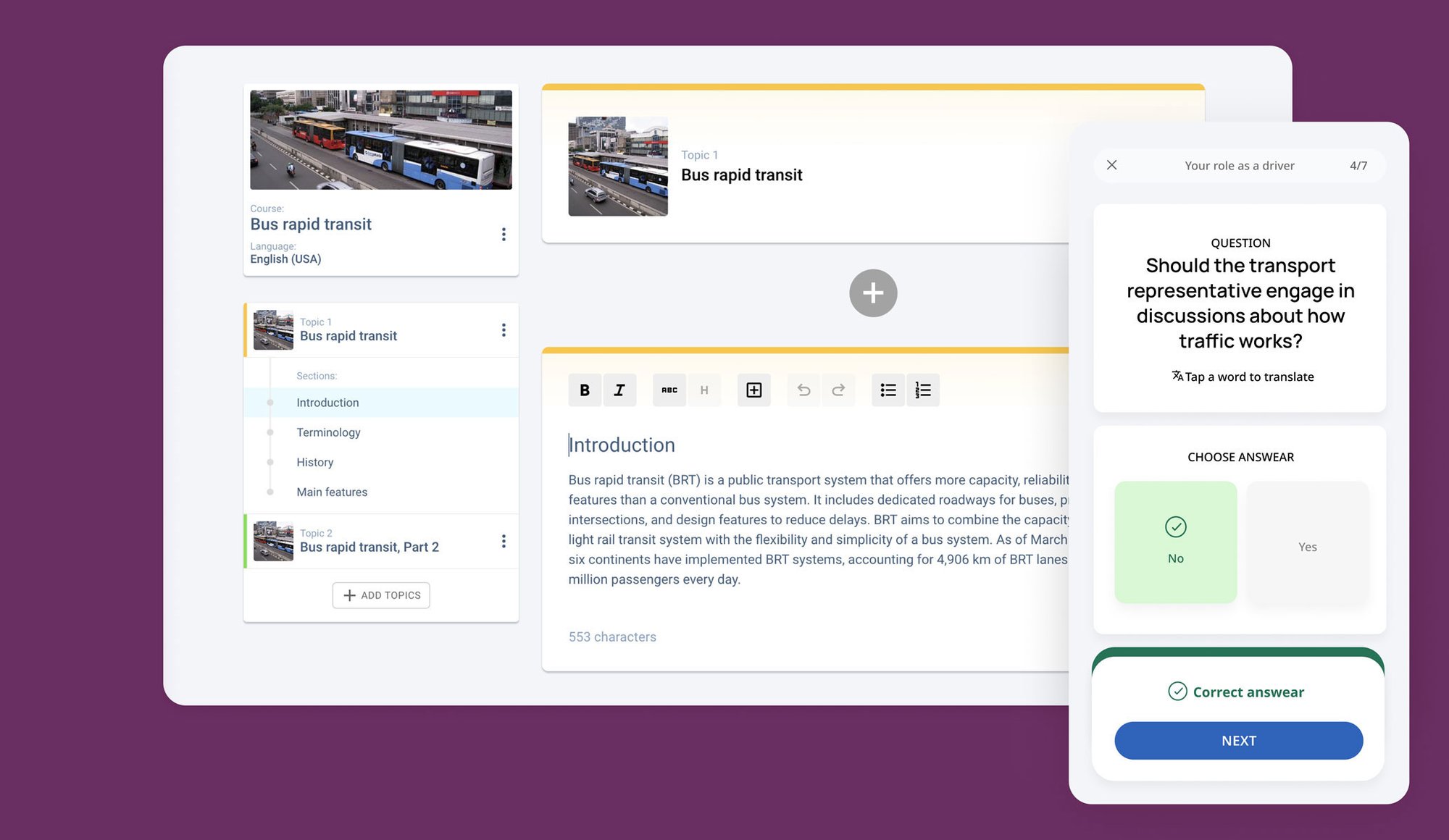25 best practices for onboarding new employees
Let’s get started on some of the best practices for onboarding new employees, starting with the benefits of creating an onboarding program with Lingio.
1. Creating an onboarding program with Lingio
Creating a training program with Lingio transforms an employee's onboarding experience into a seamless, customised journey. Using Lingio’s AI Course Creator, companies can design tailored onboarding programs in just a few clicks, perfectly suited to various roles and learning styles. Lingio’s LMS platform allows for monitoring training progress and the real-time adaptation of programs, ensuring that content remains relevant and effective as needs evolve. Additionally, Lingio enhances learner engagement by providing courses with gamification and interactive elements such as quizzes, videos, and real-time feedback mechanisms. This dynamic approach to training speeds up the learning process and significantly boost engagement and retention among new employees.

2. Pre-onboarding communication
Creating strong pre-onboarding communication is one of the best practices for onboarding, setting the tone for a new hire's journey even before their first day at their new job. This phase, often termed 'preboarding', is crucial for setting expectations, building excitement, and fostering engagement to create a positive first impression. You can also consider sending company swag, like a branded water bottle or notepad, to welcome team members into your community and ignite their enthusiasm for the new role. And providing a clear onboarding schedule via email ensures they know what awaits them. Encouraging new hires to complete administrative tasks in advance, such as filling out tax forms or reading the employee handbook, minimises day-one paperwork and maximises engagement with their new team and role.
3. First-day agenda
Creating a welcoming and structured first day is a critical onboarding best practice, pivotal in shaping a new employee's journey within your company. The goal is to balance fun and informative tasks, ensuring the day is neither overwhelmed with paperwork nor too laid back. Start by setting up your new employee’s workspace with essential tools like ID badges, passwords, and a building map, making their initial navigation easy. Arranging lunch with other employees creates early bonds and a sense of belonging. Introducing the new hire company-wide through email personalises their welcome, while a thoughtful first-day gift can make them feel truly valued. Seeking feedback from current employees about their first-day experiences provides insights for continuous improvement. Incorporating these strategies ensures the first day is engaging, informative, and devoid of unnecessary pressure, which is an excellent start to the entire onboarding process.
4. Mentor or buddy assignment
Assigning an onboarding buddy or mentor to your new hire during the first week is part of a good onboarding process, acting as a bridge for employees to integrate smoothly into the company's culture and workflow. By pairing new staff with seasoned colleagues or senior leaders, you create an environment for open dialogue and learning. These buddies serve as positive role models, eager to share insights and provide support, whether it’s navigating the office or sharing more about the team dynamics. Opting for a structure that suits your company ethos, whether formal or informal, enhances this experience. Additionally, offering shadowing opportunities across different departments, such as marketing newbies spending time with sales teams, enriches their understanding and skill set. This approach eases the transition for new staff and encourages a collaborative and inclusive workplace culture.
5. Comprehensive onboarding checklist
Creating a comprehensive onboarding checklist is one of the best employee onboarding practices to incorporate, ensuring no critical step is missed in welcoming a new hire. This checklist should cover all phases, from pre-onboarding communications to setting up technology and access permissions to scheduling training sessions and mentor meetings. It acts as a roadmap for both the human resources team and the new employee, detailing each task to be completed, like submitting paperwork, understanding company policies, and integrating into the team. Tailoring the checklist to include role-specific training and goals can further personalise the onboarding experience, creating a sense of preparedness and belonging from day one of the new job.
6. Role-specific training programs
Role-specific training programs provide new team members with the tools necessary to excel in their positions. These tailored training sessions delve into the expectations of the job, allowing newcomers to grasp critical operational procedures and technical skills swiftly. By designing these programs to address each role's unique challenges and daily tasks, companies can dramatically shorten the learning curve and boost early productivity. Furthermore, such personalised training shows the company’s commitment to individual growth and success, enhancing job satisfaction and engagement right from the start.
7. Regular check-ins and feedback
Regular check-ins and feedback are essential onboarding practices that extend well beyond the initial orientation and training period. Onboarding is an ongoing journey that benefits immensely from scheduled weekly, monthly, or quarterly meetings, depending on the role and company. These sessions provide vital touchpoints where new hires can discuss their experiences, voice concerns, and receive constructive feedback. Acknowledging their contributions boosts morale and reinforces their value within the team. Asking if staff require further training or support helps tailor their future development path and ensures they feel equipped to handle their responsibilities. Effective check-ins are pivotal, often making the difference between retaining a long-term, productive employee and losing them prematurely.
8. Clear goals and expectations
Setting clear goals and expectations is one of the best onboarding practices for new employees, providing a structured roadmap for their early days and beyond. By establishing specific milestones for the first 30, 60, and 90 days during the first week of the job, companies can clarify what success looks like to them and also help new hires focus on achievable objectives. Open communication about job duties, compensation, and perks enhances transparency and builds trust. Creating attainable, well-defined short-term and long-term goals allows employees to see their potential growth trajectory within the company, reinforcing a culture of support and respect.
9. Company culture introduction
Introducing company culture effectively is fundamental to creating good onboarding practices. From day one, it's crucial to embed the organisation’s values and ethos, helping new hires align their personal beliefs and goals with the company’s vision. Sharing the company history, along with its mission statement and core values, educates and inspires new employees about their workplace. Highlighting unique aspects of the culture and the reasons behind long-term employee loyalty can significantly boost engagement and motivation. By transparently showcasing what makes the company a great workplace, you cultivate a positive work environment that encourages productivity and satisfaction. This cultural integration ensures new employees feel connected and committed from the outset.
10. Social integration events
Introducing social integration events to staff is one of the best practices for employee onboarding, aimed at enhancing team bonding and interdepartmental connections and addressing both social and performance aspects. According to SHRM 2022, 32% of workers want onboarding to include a social element, and 44% desire more training in communication skills. Companies can facilitate this by organising team-building activities that help new hires feel comfortable and encourage collaboration in engaging non-work-related scenarios. Additionally, promoting cross-functional interactions and out-of-work social gatherings allows new employees to forge significant relationships across different levels of the organisation. These efforts can make onboarding enjoyable and integrate new hires into the company culture and community effectively.
11. Resource library
Providing a well-structured resource library is integral to the onboarding procedure, embodying best practices by offering new hires easy access to essential company policies, processes, and tools. A comprehensive resource library helps streamline the acclimation period and ensures that all employees have uninterrupted access to critical information, which enhances consistency and compliance across the organisation. It can include everything from HR department documents, safety protocols, and ethical guidelines to training videos and management tools.
12. Collaborative tools for integration
Leveraging technology such as project management software, real-time communication platforms, and training tools such as Lingio creates a culture of open communication and teamwork from the outset, which is especially helpful for onboarding remote employees. Remote employee onboarding best practices like these enable new hires to seamlessly connect with their colleagues, participate in ongoing projects, and contribute effectively, regardless of geographical barriers. Such technologies can streamline workflows and enhance transparency and accountability within teams. By introducing these tools during onboarding, companies equip new employees with the necessary resources to collaborate efficiently, ensuring a smoother transition and quicker adaptation to their roles.
13. Early task engagement
Early task engagement during the first week or even later is crucial during onboarding, providing new hires with practical, job-related tasks that enhance their understanding and integration into their roles. This engagement should include opportunities to shadow colleagues, participate in projects, and engage in training, all tailored to impart a real-world grasp of their responsibilities. However, it’s important not to overwhelm new recruits. Initial tasks should be manageable, allowing new employees to build confidence and contribute meaningfully without the risk of burnout. Organisations should facilitate a gentle ramp-up in workload, complemented by periodic reviews to reinforce skills and knowledge. This approach maintains employee enthusiasm and energy and fosters a smoother adjustment to the company's work rhythm and culture, ultimately enhancing productivity and reducing early-stage errors.
14. Accessibility and inclusivity
Designing materials that cater to diverse needs and learning styles is fundamental to the best employee onboarding processes. Accessibility and inclusivity should be at the forefront of creating onboarding content, ensuring that all materials are understandable and usable by employees with different abilities and from various cultural backgrounds. This can include providing content in multiple formats like videos, written documents, and interactive tools, all compliant with accessibility standards. This approach ensures no employee feels disadvantaged, promoting a welcoming and supportive workspace. Implementing these practices demonstrates a company's commitment to diversity and inclusion, cultivating an environment where every team member can thrive from day one.
15. Onboarding survey for improvement
Sharing an onboarding survey for improvement is one of the most effective onboarding practices to include in your process. Regularly collecting feedback through surveys or direct conversations with recent hires provides invaluable insights into the strengths and weaknesses of the current onboarding plan. This continuous feedback loop allows the HR department to identify areas needing enhancement and to adapt strategies to better meet the needs of new staff. Being open to revamping the onboarding procedure as the company grows and evolves ensures that it remains aligned with organisational changes and employee satisfaction and expectations.
16. Growth and future development paths
Highlighting growth and development opportunities during onboarding is crucial for motivating new hires and setting the tone for their career progression within the company. Effective onboarding practices should include a clear presentation of the future opportunities available, outlining potential career trajectories and the competencies required to achieve these goals. This helps employees visualise their future at the company and aligns their personal career aspirations with organisational objectives. Companies should provide resources and tools to support employee growth, such as mentorship programs, training sessions, and clear metrics for advancement. Such transparency and support underscore a commitment to employee development and foster a culture of ambition and achievement.
17. Well-being programs
Offering well-being programs is essential in demonstrating how to best onboard new employees. These programs support not only their professional growth but also their physical and mental health. Integrating these programs into onboarding communicates a company’s commitment to the holistic health of its staff.
Initiatives can include access to, but not limited:
- Mental health resources
- Wellness workshops
- Ergonomic assessments
- Fitness memberships
By prioritising staff well-being, companies create a supportive workplace environment that enhances the employee experience, reduces stress, and improves overall productivity.
18. Onboarding portal
An onboarding portal centralises all essential resources and communications, embodying best practices for new employee onboarding. Utilising platforms like Lingio, companies can consolidate onboarding-related content, such as training materials and development programs into an accessible online hub. This approach simplifies onboarding for new hires, allowing them to find their training in one place without the hassle of navigating multiple systems. By streamlining communication and resources, an onboarding portal ensures employees a smooth, cohesive start. It also enables HR teams to update, manage, and track training efficiently, ensuring that all information remains current and being able to pinpoint when staff need help.
19. Automating routine processes
Automating routine processes is a key element in onboarding and orientation best practices. By using HR software, companies can streamline the administrative aspects of onboarding, from managing paperwork to scheduling compliance checks. This automation reduces the risk of human error and frees up HR professionals to focus on more strategic, high-value interactions with new hires. For example, automated systems can ensure that employment forms are submitted and processed promptly, benefits are enrolled correctly, and IT setups are completed before the new employee's first day. This efficient use of technology accelerates onboarding and improves the overall experience for both HR teams and employees, making it seamless and integrated.
20. Remote onboarding strategies
Remote onboarding strategies are crucial in implementing best practices in employee onboarding, particularly when integrating hires who work from afar. This process requires clear communication, robust digital work related tools, and structured virtual interactions to replicate the in-office experience as closely as possible.
Key strategies for onboarding remote employees include:
- A virtual office tour
- Digital meet-and-greets with co workers
- Comprehensive online training sessions
Ensuring that remote hires have access to all necessary technological tools and support systems is vital. Regular virtual check-ins can help mitigate feelings of isolation, allowing remote employees to feel connected and part of the team.
21. Engaging video content

Providing engaging video content is one of the best practices in onboarding and employee orientation, significantly enhancing the engagement and retention of new hire information. By incorporating multimedia elements, companies can transform traditional, often tedious information into interactive and appealing visual experiences. Videos can effectively convey organisational culture, clarify complex procedures, and provide step-by-step training that’s both accessible and memorable. Whether it's animated explainers, recorded messages from leadership, or virtual office tours, incorporating video ensures that new employees receive a consistent message and feel a personal connection to the company, even before they enter the workplace.
22. Early feedback opportunities
Inviting a new employee to share their insights and suggestions soon after they begin their role empowers them and conveys that their opinions are valued. This practice can significantly enhance the onboarding process by identifying areas needing improvement and adjustments. It also helps in building a culture of open communication and continuous improvement. Implementing structured feedback sessions, whether through one-on-one meetings, surveys, or informal check-ins, allows organisations to address any concerns in real-time and adapt the onboarding experience to better meet the needs of future employees. This proactive engagement leads to more satisfied and well-integrated team members.
23. Celebrating milestones
Celebrating milestones is pivotal when planning the best onboarding process for new employees, building motivation and demonstrating appreciation for employees’ efforts. Recognising achievements during onboarding, such as completing training courses or early successes in their roles, can significantly enhance employee engagement and satisfaction. This could be through public acknowledgements in team meetings or tangible rewards such as bonuses or additional perks.
24. External training opportunities
Encouraging external training opportunities is an integral part of creating the best onboarding process for new employees, aimed at cultivating continuous professional development. Although most onboarding programs conclude within 90 days to a year, the pursuit of learning extends far beyond. A striking 89% of L&D departments affirm the growing necessity to enhance employee skills for future workplace demands. Companies can support this by providing access to free upskilling or reskilling programs. Approximately 37% of companies currently offer reskilling, with an additional 56% planning to do so within the year. Additionally, clearly explaining promotion pathways and criteria during onboarding helps new hires understand their potential career progression.
25. Flexible onboarding approach
Adapting the onboarding process to individual needs and feedback is essential for optimising the integration of new hires. While a structured approach is beneficial, flexibility can significantly enhance effectiveness. For example, allowing flexibility in training schedules, like allowing staff to complete training on their own time, can prevent burnout and increase engagement. The SHRM 2022 study highlights that while 75% of employees were satisfied with their training, 11% expressed dissatisfaction, underscoring the importance of a flexible, adaptable approach. The best onboarding process recognises diverse learning styles and the need for personalisation, creating an environment where new hires feel their concerns are respected and their needs are met.







